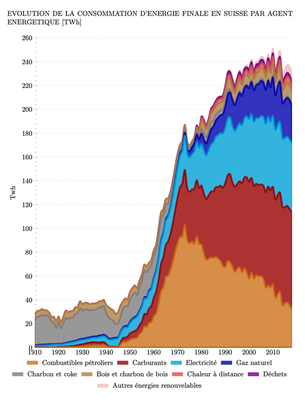Why does our energy mix contain two-thirds fossil fuels?
The fact that almost two-thirds of our final energy needs (63% in 2017) are currently met by fossil products imported from abroad is a result of their high availability, their technical as well as economic benefits, and the inertia of our energy system, which does not have the capacity to move quickly towards alternative solutions.
Between 1950 and 1970, Switzerland almost quadrupled its final energy demand, a result of strong economic and demographic growth. This increase was covered almost exclusively by petroleum products (petrol, diesel and heating oil). The result was a high dependence on oil, which peaked in the early 1970s, when 80% of our energy needs were met by petroleum products.
Since then, while final energy demand has continued to grow, from 190 TWh in 1973 to some 230 TWh today [→ see figure below], imports of petroleum products have remained stable around 130 TWh and have decreased in recent years to about 120 TWh, reducing our dependence on hydrocarbons (petroleum products and natural gas) from 80% to almost 60%. This is the result of a reduction in the heat requirements of new (better insulated) buildings, and of the improvement of oil-fired boilers or their replacement, mainly by gas boilers and electric heating. Today it is these same electric heaters that are strongly contested [→ Q26], even though the authorities had promoted them in order to increase security of supply following the 1973 and 1979 oil crises.
Consumption of petrol, diesel and natural gas (for road transport) and kerosene (for aviation) continued to increase until 2010, in the absence of an alternative to fossil fuels, to meet the growing demand for mobility. However, the steady improvement in the energy efficiency of road vehicles has limited this increase in fuel consumption to about 12% over this period, while the number of vehicles overall increased by more than 40%.
Apart from electricity, our energy system is therefore deeply based on fossil fuels, whether for heating (oil and natural gas) or transport (petrol, diesel and, to a lesser extent, gas). Switzerland even imports about 10 million tonnes of crude oil and finished petroleum products per year: approximately 5 million tonnes of crude oil each year per pipeline, which it transforms into finished products (petrol, diesel and oil) at the Collombey (Canton of Valais) and Cressier (Canton of Neuchâtel) refineries, and imports the balance of its consumption directly in the form of finished petroleum products [→ Q21].
It was not until the 2000s that new renewable energies really began to replace fossil fuels. However, they are still too small to play a significant role in the current energy mix [→ Q47].

References
- Office fédéral de l'énergie (OFEN) (2019)
- Office fédéral de l'énergie (OFEN) (2019). Statistique globale de l’énergie 2018. OFEN.
- Office fédéral de la statistique (OFS) (2019)
- Office fédéral de la statistique (OFS) (2019). Energie: Panorama. OFS.